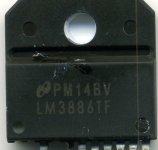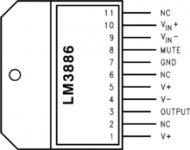Oscillation will not kill an Overture part (LM3886 is one) out right. Instead it will get hot and then Spike protection will come on followed by thermal shutdown. Shorting leads to different supplies will also not necessarily kill it either. If you ever attached it to a heat sink it is possible to over tighten the mounting screw and crack the die but you have to crank it pretty good. Power up with out a LM3886 in the board and check all the voltages at the pins. Then try another one.
-SL
-SL
sayang001 said:
Desolder the chip from the pcb and put it on the scanner with it's front, it is broken anyway
Here is the picture of the frontside.
Attachments
SpittinLLama said:Oscillation will not kill an Overture part (LM3886 is one) out right. Instead it will get hot and then Spike protection will come on followed by thermal shutdown. Shorting leads to different supplies will also not necessarily kill it either. If you ever attached it to a heat sink it is possible to over tighten the mounting screw and crack the die but you have to crank it pretty good. Power up with out a LM3886 in the board and check all the voltages at the pins. Then try another one.
-SL
Hi Spittinlama,
I will check the voltages tomorrow and report back.
Thanks for your advice.
Regards,
Lucas
Lucas_G,
Your LM3886TF is fake The one I have at home are the same as the picture below:
The one I have at home are the same as the picture below:
Compare the National Logo , Text Font and casing.
Also try to remove the plastic casing and see what is undernead.
Your LM3886TF is fake
An externally hosted image should be here but it was not working when we last tested it.
Compare the National Logo , Text Font and casing.
Also try to remove the plastic casing and see what is undernead.
SpittinLLama said:Oscillation will not kill an Overture part (LM3886 is one) out right. Instead it will get hot and then Spike protection will come on followed by thermal shutdown. Shorting leads to different supplies will also not necessarily kill it either. If you ever attached it to a heat sink it is possible to over tighten the mounting screw and crack the die but you have to crank it pretty good. Power up with out a LM3886 in the board and check all the voltages at the pins. Then try another one.
-SL
Hi Spittinlama,
Today I checked voltages on the board:
Pins from left to right:
1= +33
2= 0
3= 0
4= -33
5= +33
6= 0
7= 0
8= -33
9= 0
10= 0
11= 0
I think all voltages are right, except maybe for pin 8?
The diagram states that pin 8 is for mute....?
Any comment?
Regards,
Lucas
Attachments
sayang001 said:Lucas_G,
Your LM3886TF is fakeThe one I have at home are the same as the picture below:
An externally hosted image should be here but it was not working when we last tested it.
Compare the National Logo , Text Font and casing.
Also try to remove the plastic casing and see what is undernead.
Hi Sayang001,
Do you really thinks so?
I have no idea how to open this chip. The housing seems heremtically sealed...
Lucas
sayang001 said:Your LM3886TF is fakeThe one I have at home are the same as the picture below:
Unlikely, I can't see the market being big enough to support fakes.
pinkmouse said:Pin 8 should be connected to the negative supply, but via a current limiting resistor. Check your PCB.
Hi Pinkmouse,
I just measured a resistance of 10k Ohm from pin 8 to the V- entrance. This should be OK then?
Lucas
pinkmouse said:Yup, that's fine for those rails.
Hi Pinkmouse,
Well that's that then.
This means that everything was ok with the PSU and Amp board, and that the LM3886 was either fake or just a faulty one.
So I will just connect the other channel and see whether "l 'histoire se repête".
I will order new LM3886 through RS-Components.
This all adds to a new Murphy law: "If you choose the simpliest of simple DIY projects, your main component will be rotten...
Thanks all for your advice BTW.
Lucas
Simple projects are sometimes the most difficult to debug! I built a 4780 that had a really strange distortion on the scope, the top and bottom thirds of the sine wave were perfect, but the middle had about 10% white noise superimposed over the top. In the end, I tracked it down to a dodgy solder joint on the mute pin that looked fine, though when resoldered it fixed the problem, though I still don't know how that affected the waveform in that way.
It is possible to defeat the spike protection on the LM chips though, I managed to blow up another 4780 on sustained testing on a 4ohm sub driver...
It is possible to defeat the spike protection on the LM chips though, I managed to blow up another 4780 on sustained testing on a 4ohm sub driver...
pinkmouse said:Do you have an old speaker you can use for testing, and is that 80mV measured with the input shorted?
Yes, good idea. I will first use an old speaker.
The 80mV is with the ipit not shorted. Should I also check soldered?
http://www.diyaudio.com/forums/showthread/t-33335.html
destroyer X had the same as you, also exploding LM3886
destroyer X had the same as you, also exploding LM3886
Hi all
One thing that hasn't been mentioned yet, and that I learned by letting the smoke out of more than one chip...
The heat sink tab is NOT at ground potential on any of these chips. It is at V- potential. If your chip mounting tab makes electrical contact with the heatsink, and the heatsink is grounded, poof!!
I notice from one of the previous pix that the inside of the mounting hole appears to be exposed metal. If you did not use insulating washers then that's why the chip blew up.
This won't apply of it wasn't mounted to a heatsink when you first powered up, but if it was...
Jess
One thing that hasn't been mentioned yet, and that I learned by letting the smoke out of more than one chip...
The heat sink tab is NOT at ground potential on any of these chips. It is at V- potential. If your chip mounting tab makes electrical contact with the heatsink, and the heatsink is grounded, poof!!

I notice from one of the previous pix that the inside of the mounting hole appears to be exposed metal. If you did not use insulating washers then that's why the chip blew up.
This won't apply of it wasn't mounted to a heatsink when you first powered up, but if it was...
Jess
Many expensive lessons to learn, burning chips, breaking pins off, dropping soldering iron, the value of good silver based ointment for finger burns etc...
With internal heatsinks this can be an advantage... I connect my chips to the heatsink directlywithout any insulation for better thermal transfer...
The whole heatsink is then at V- but it still doesn't shock you if you touch it... but most importantly it is isolated from the case
If you want to go nuts you can lap the back of the chip and the heatsink using some fine waterpaper glued to a mirror
With internal heatsinks this can be an advantage... I connect my chips to the heatsink directlywithout any insulation for better thermal transfer...
The whole heatsink is then at V- but it still doesn't shock you if you touch it... but most importantly it is isolated from the case
If you want to go nuts you can lap the back of the chip and the heatsink using some fine waterpaper glued to a mirror
JesseG said:Hi all
One thing that hasn't been mentioned yet, and that I learned by letting the smoke out of more than one chip...
The heat sink tab is NOT at ground potential on any of these chips. It is at V- potential. If your chip mounting tab makes electrical contact with the heatsink, and the heatsink is grounded, poof!!
I notice from one of the previous pix that the inside of the mounting hole appears to be exposed metal. If you did not use insulating washers then that's why the chip blew up.
This won't apply of it wasn't mounted to a heatsink when you first powered up, but if it was...
Jess
Hi Jess,
In my case the heatsink was not connected to ground anyway, so that could not have been the case.
My second channel worked right away. With the input shorted I had a DV of only 5 mV.
I then desoldered a LM3886 from one of my "audiophile 3886" amps (Mauro) and this way I could also get a perfectly working second channel. I have been listening now for about 2 days, and I must say (much to my regret, because it kills our hobby) that these amps sound damn good!
I will get back on this later.
Regards, and thanks to all fro their help,
Lucas
- Status
- This old topic is closed. If you want to reopen this topic, contact a moderator using the "Report Post" button.
- Home
- Amplifiers
- Chip Amps
- Smoking Chipamp

